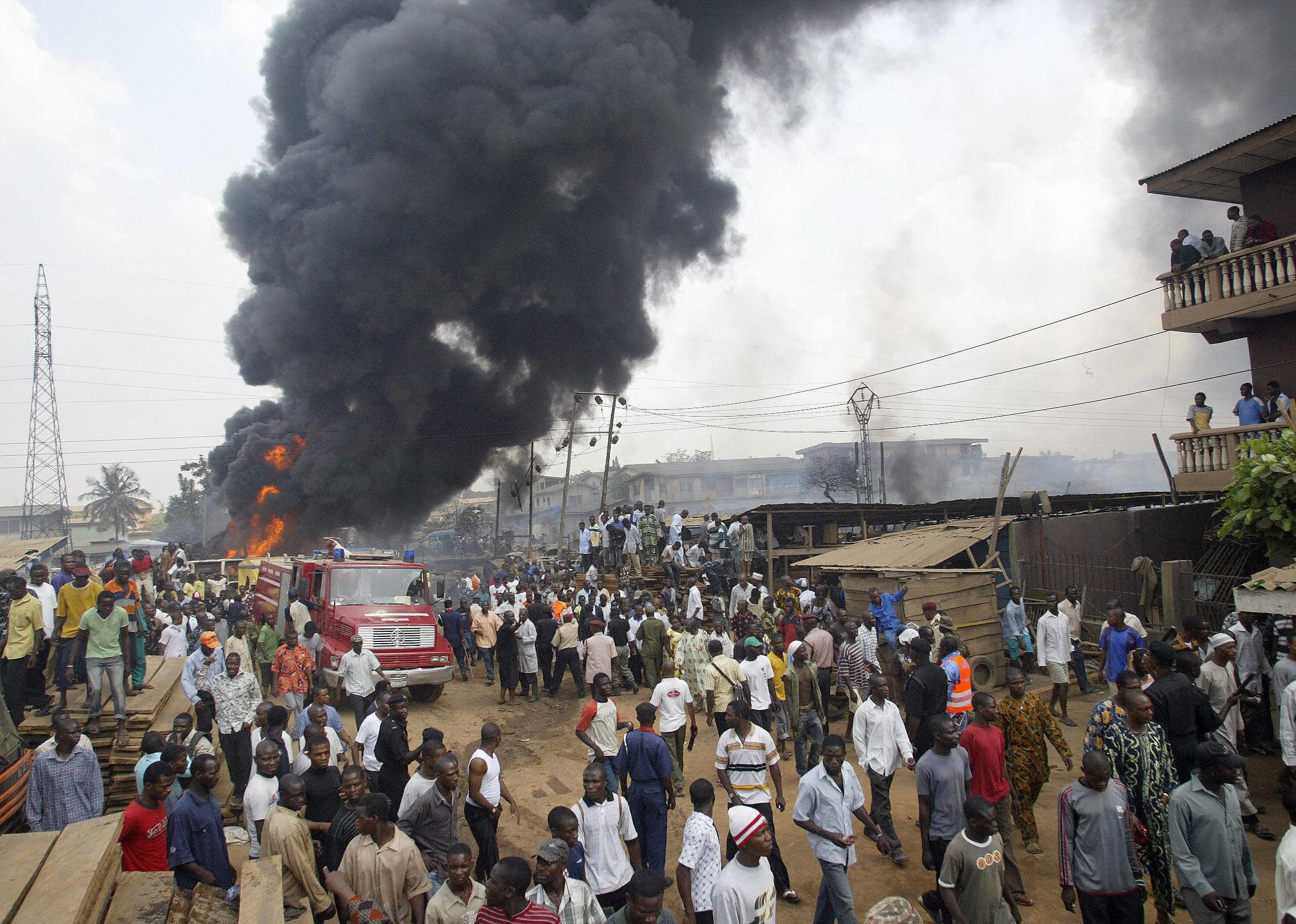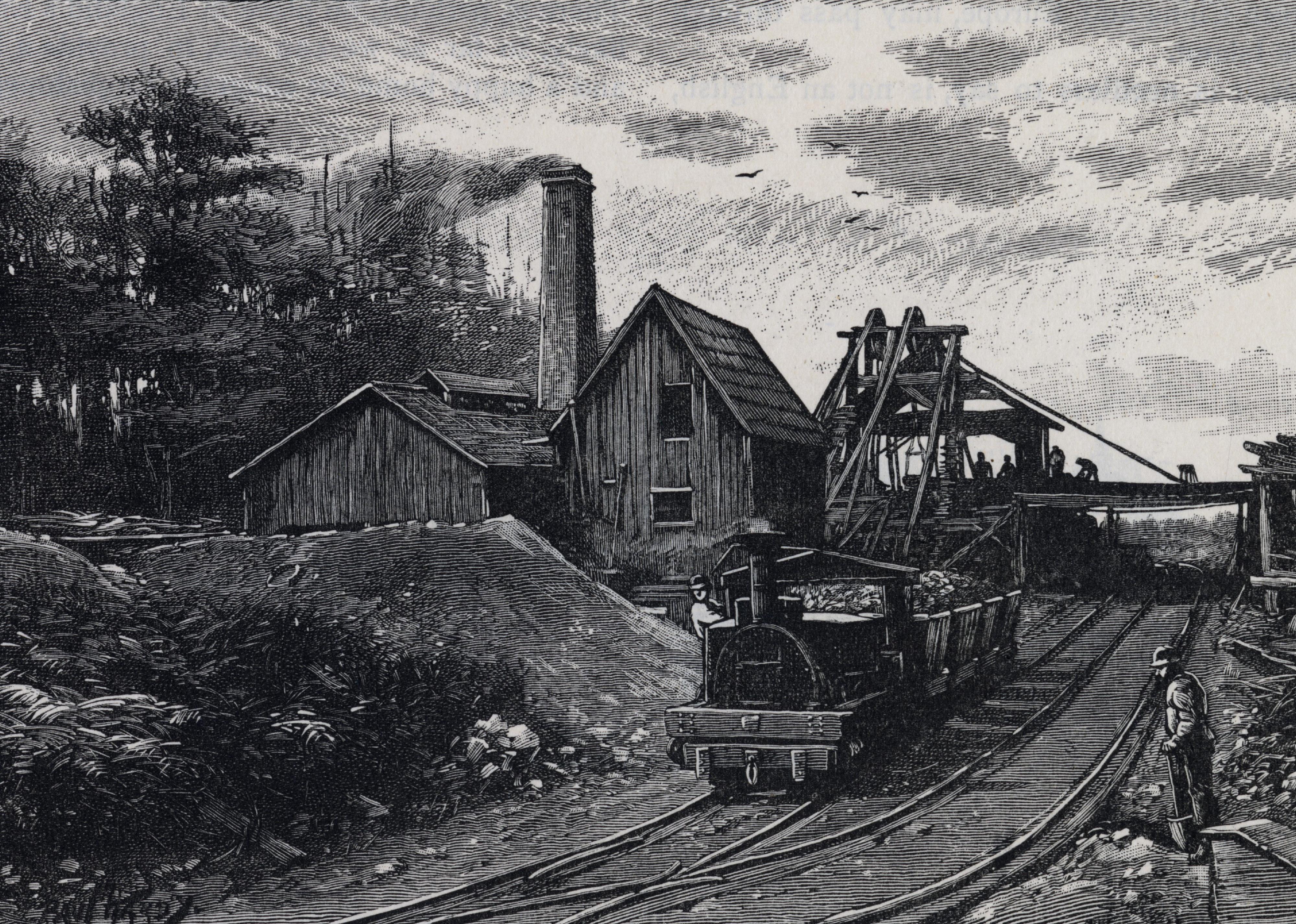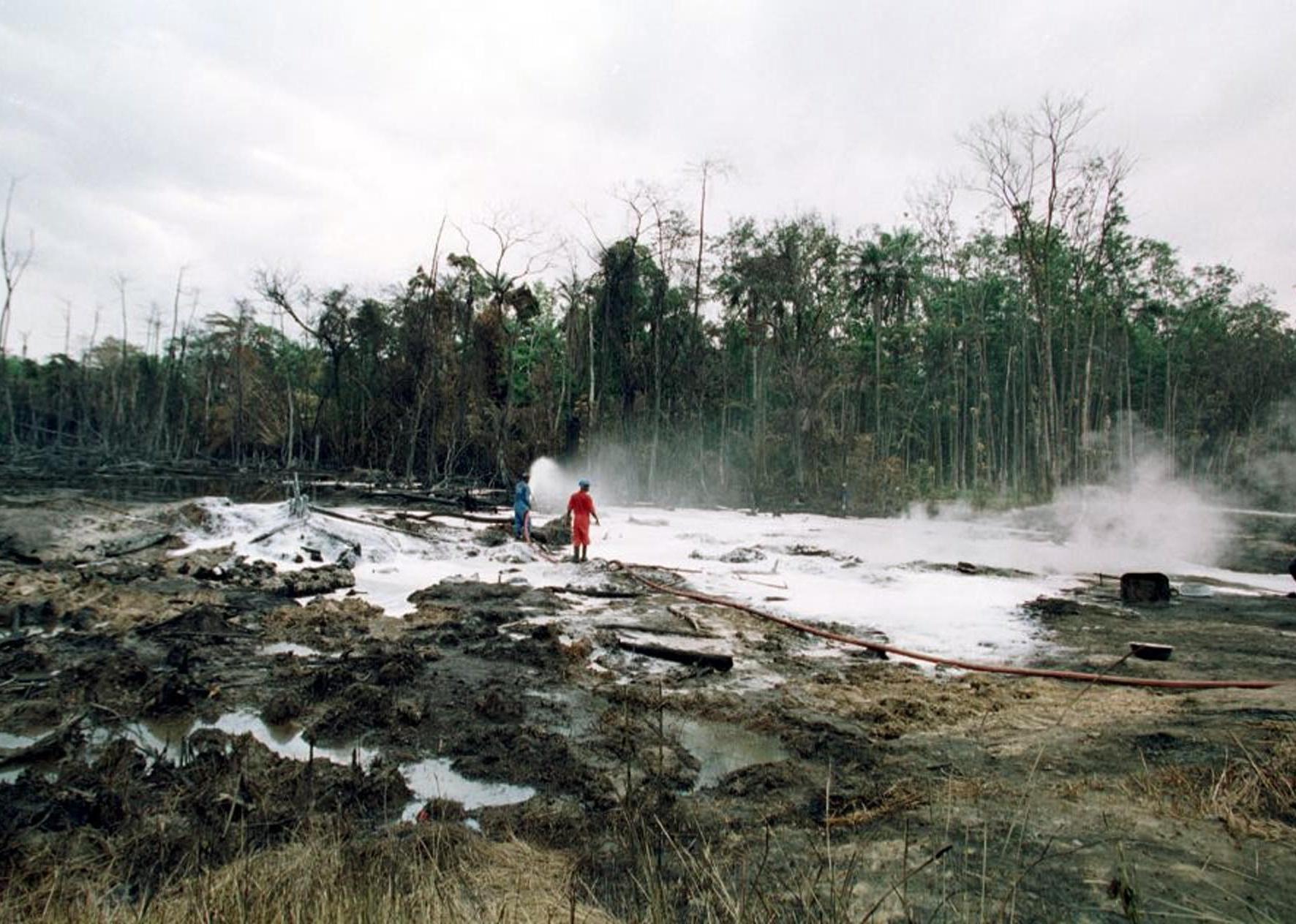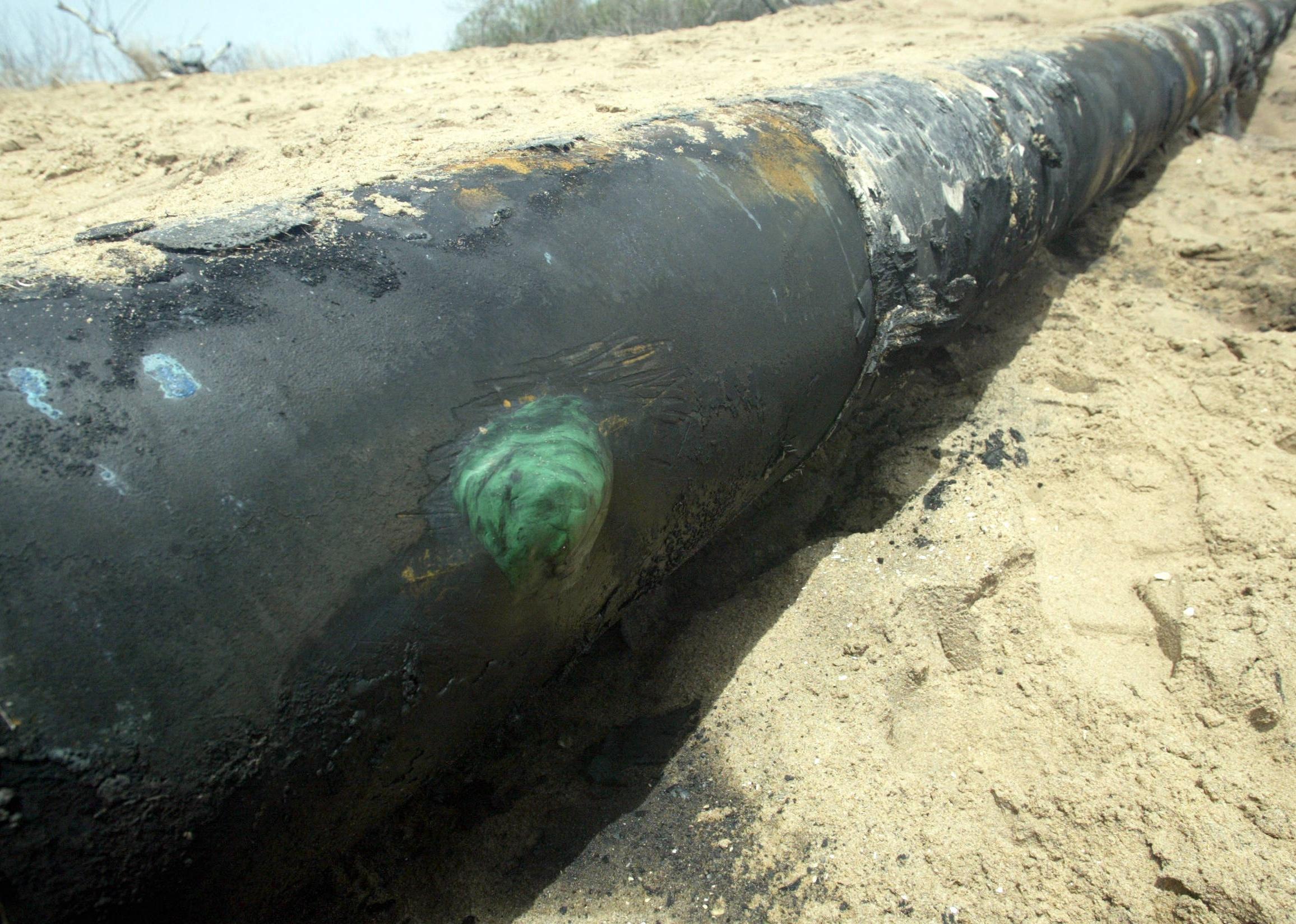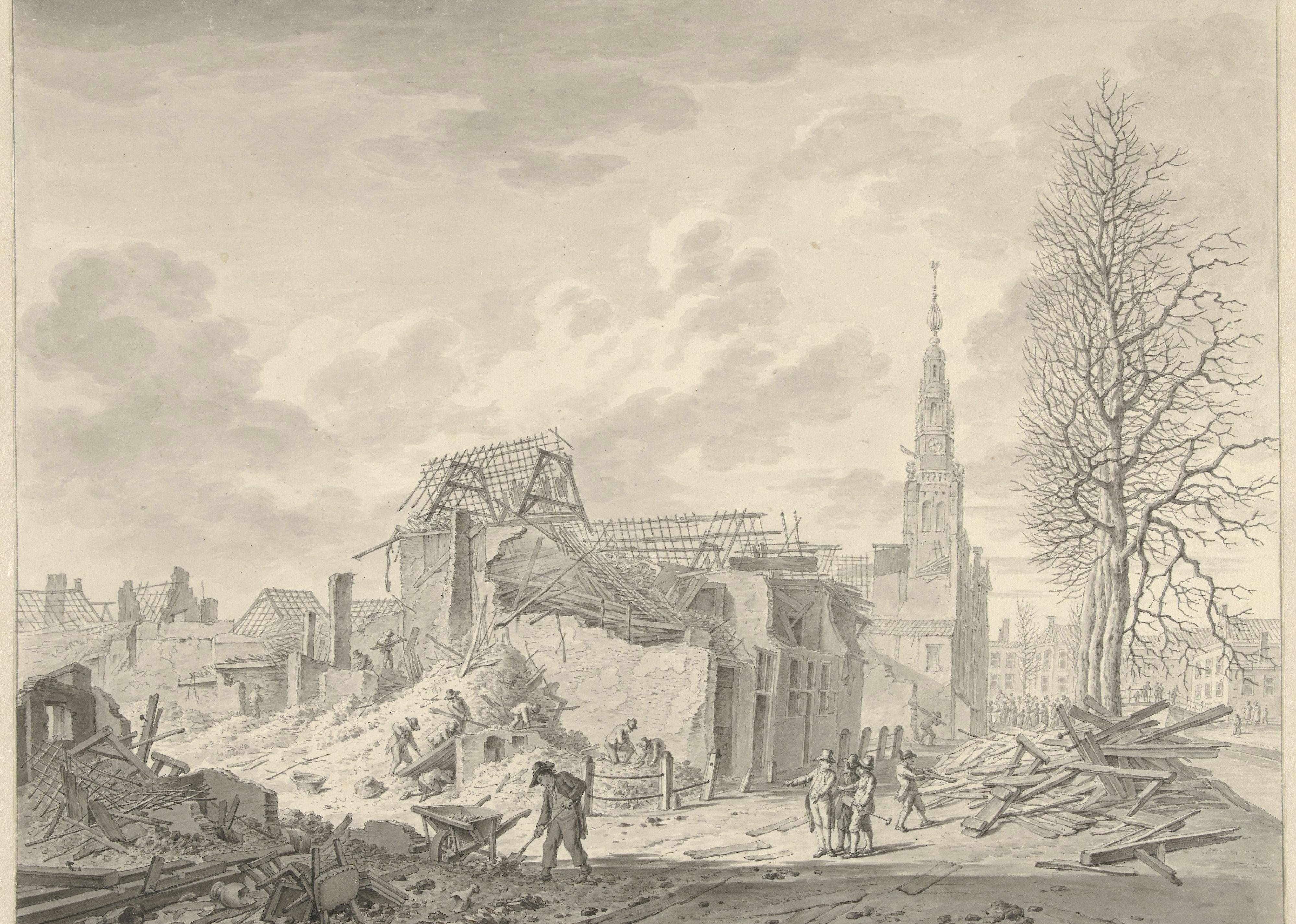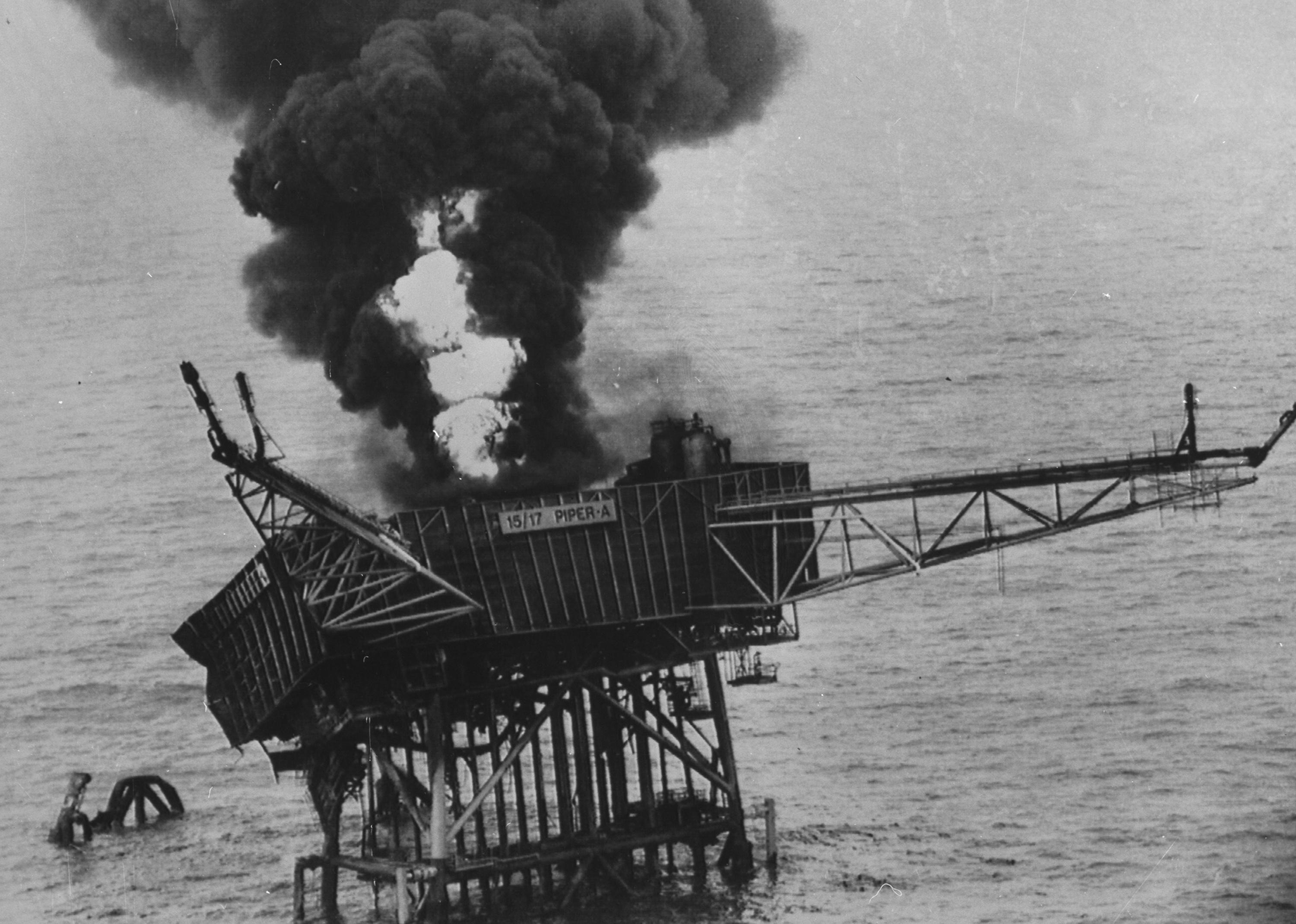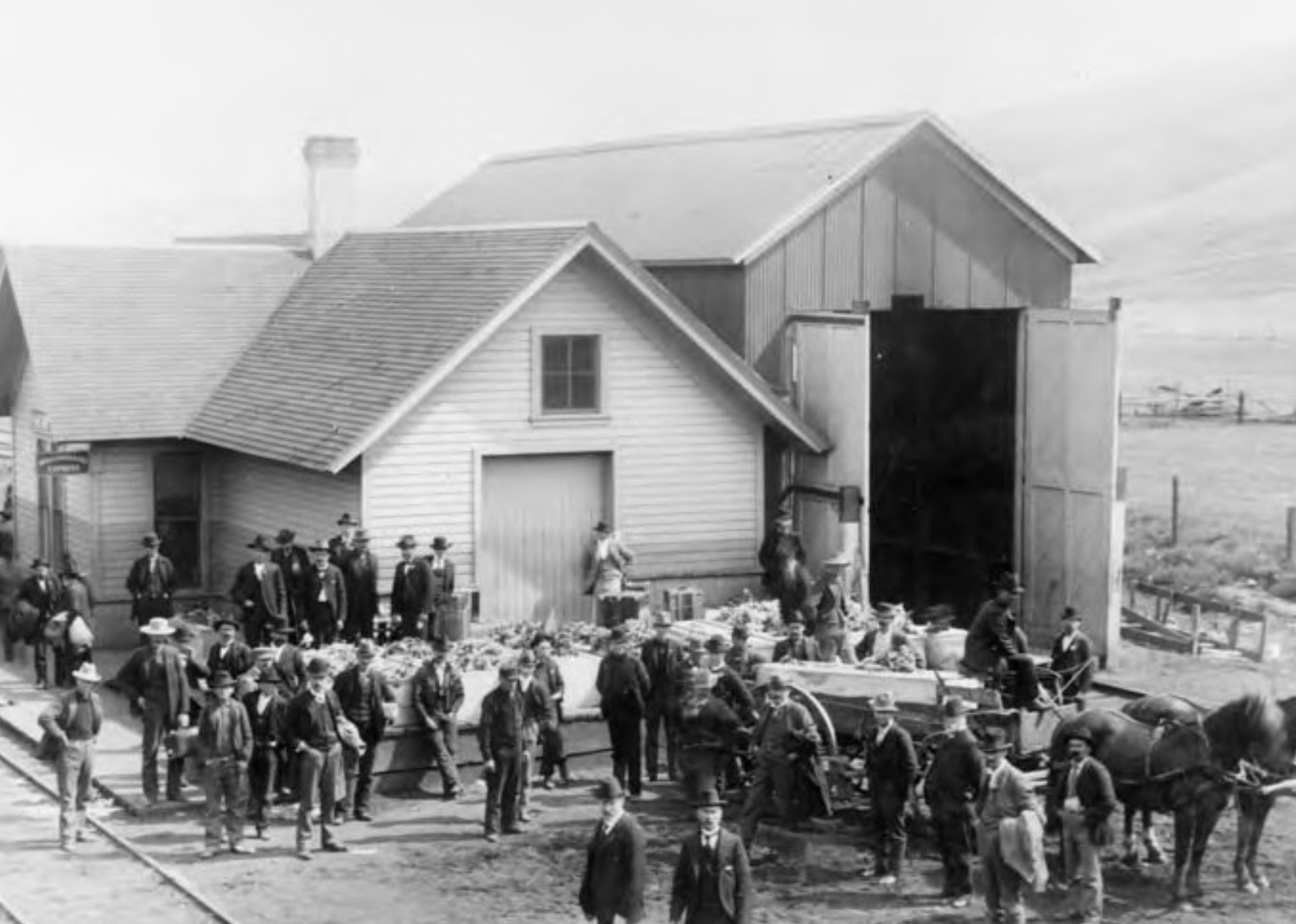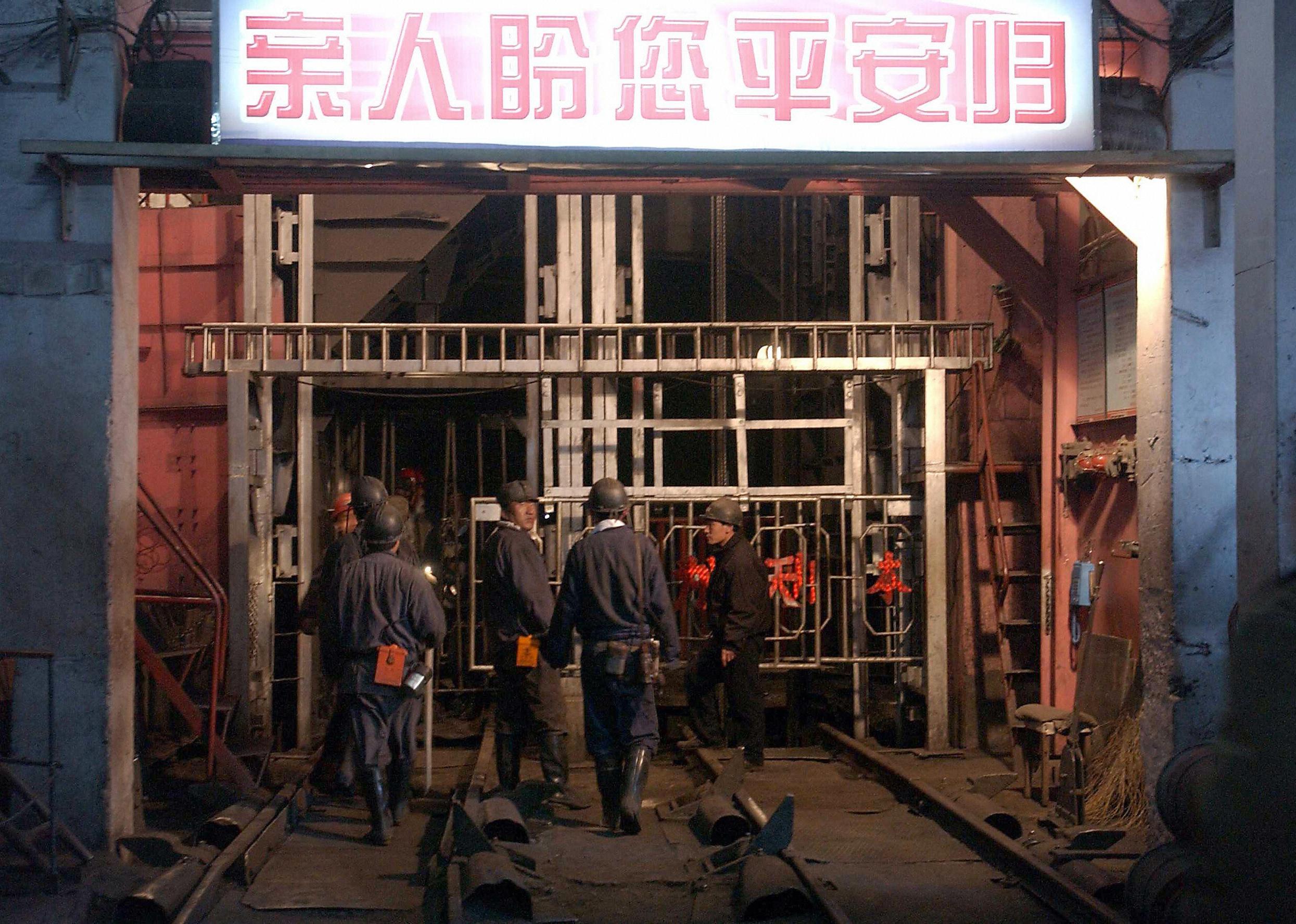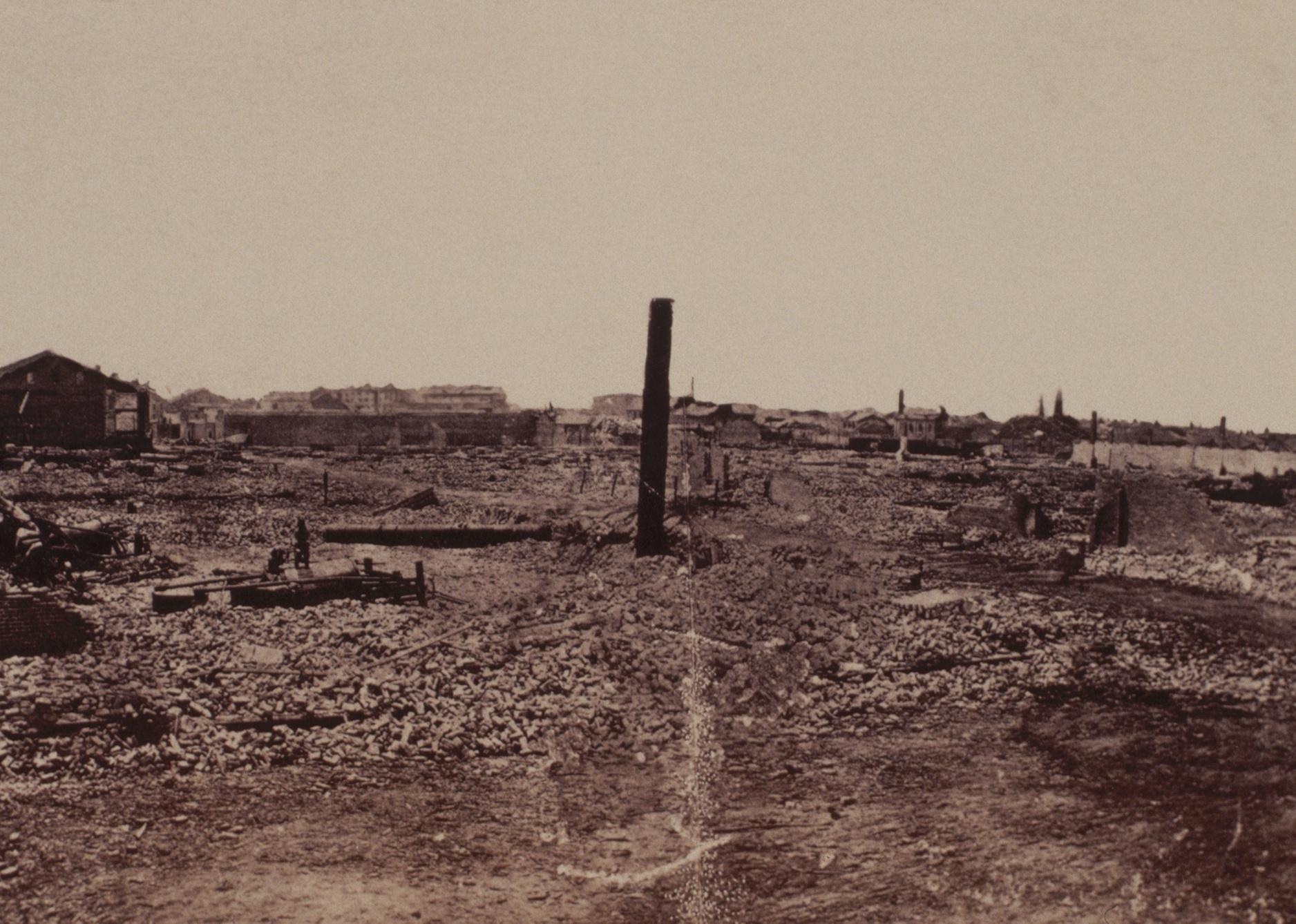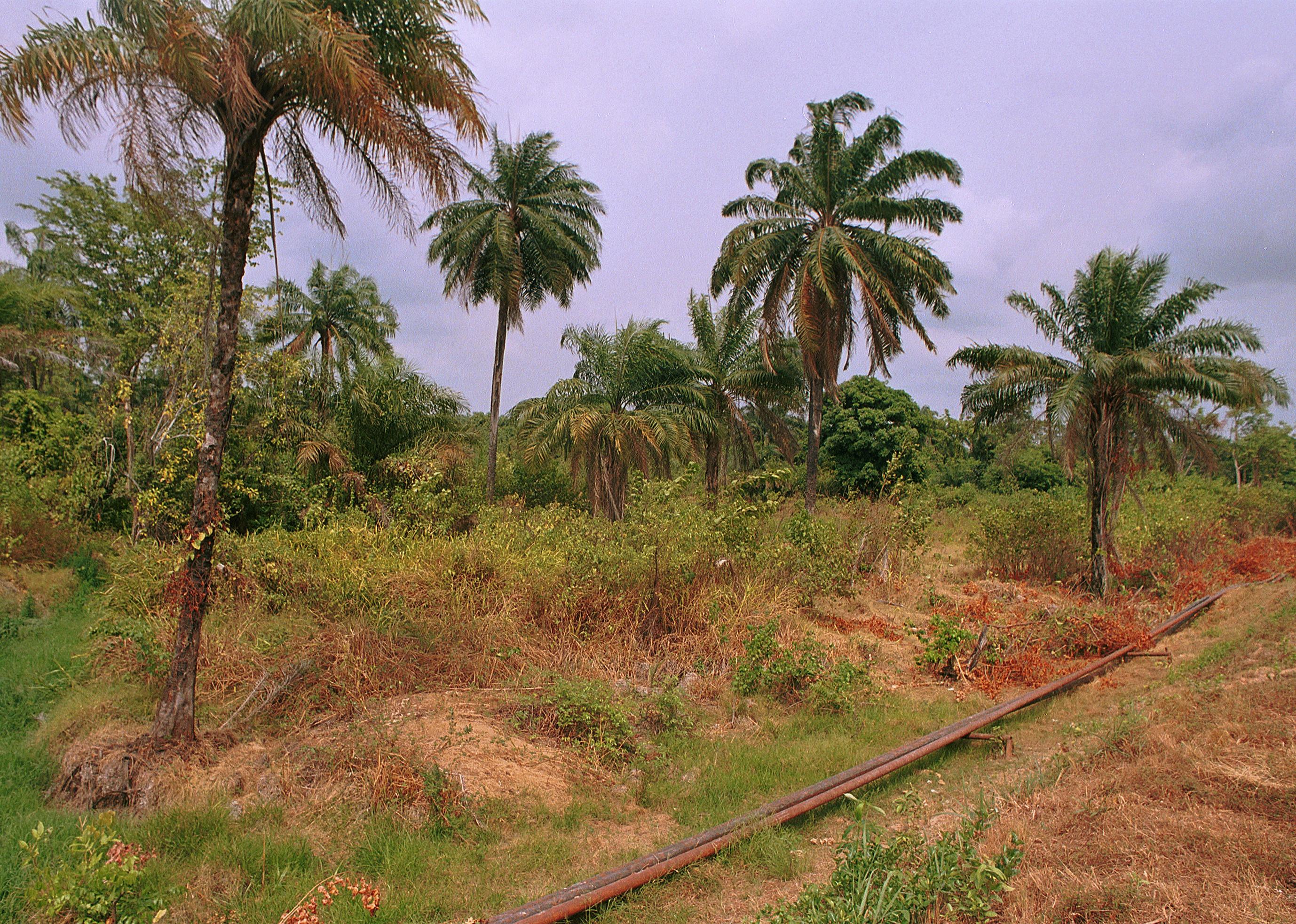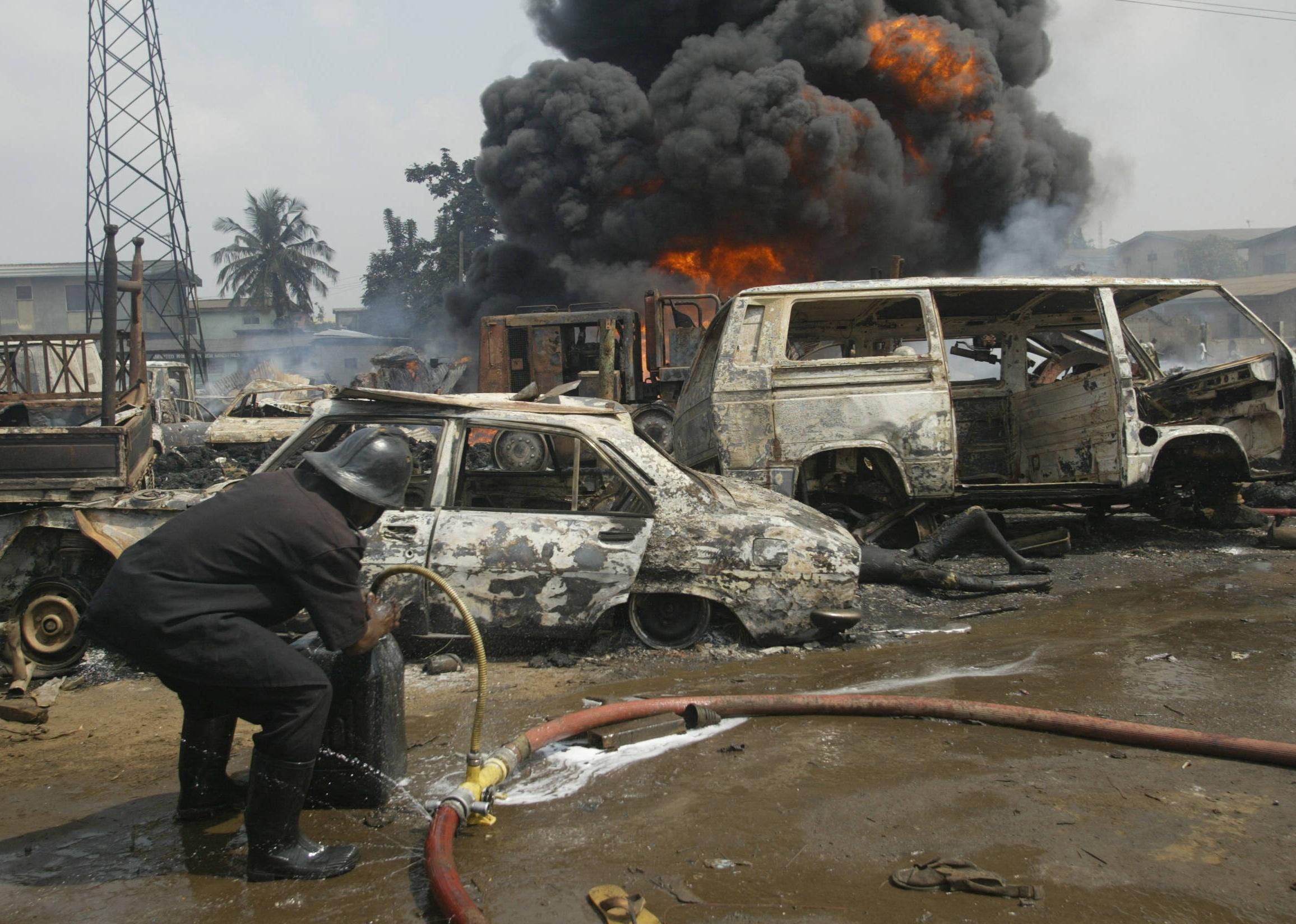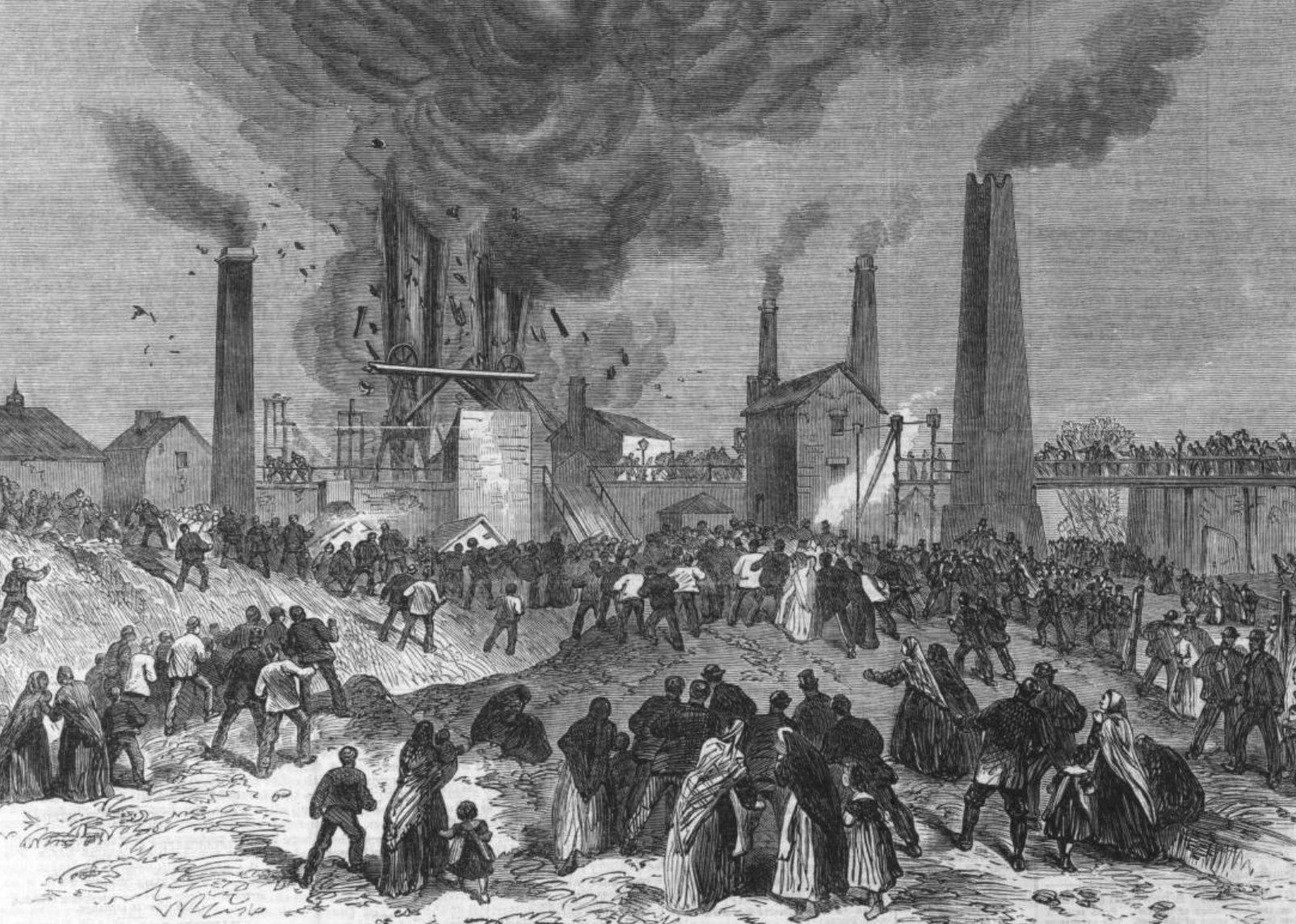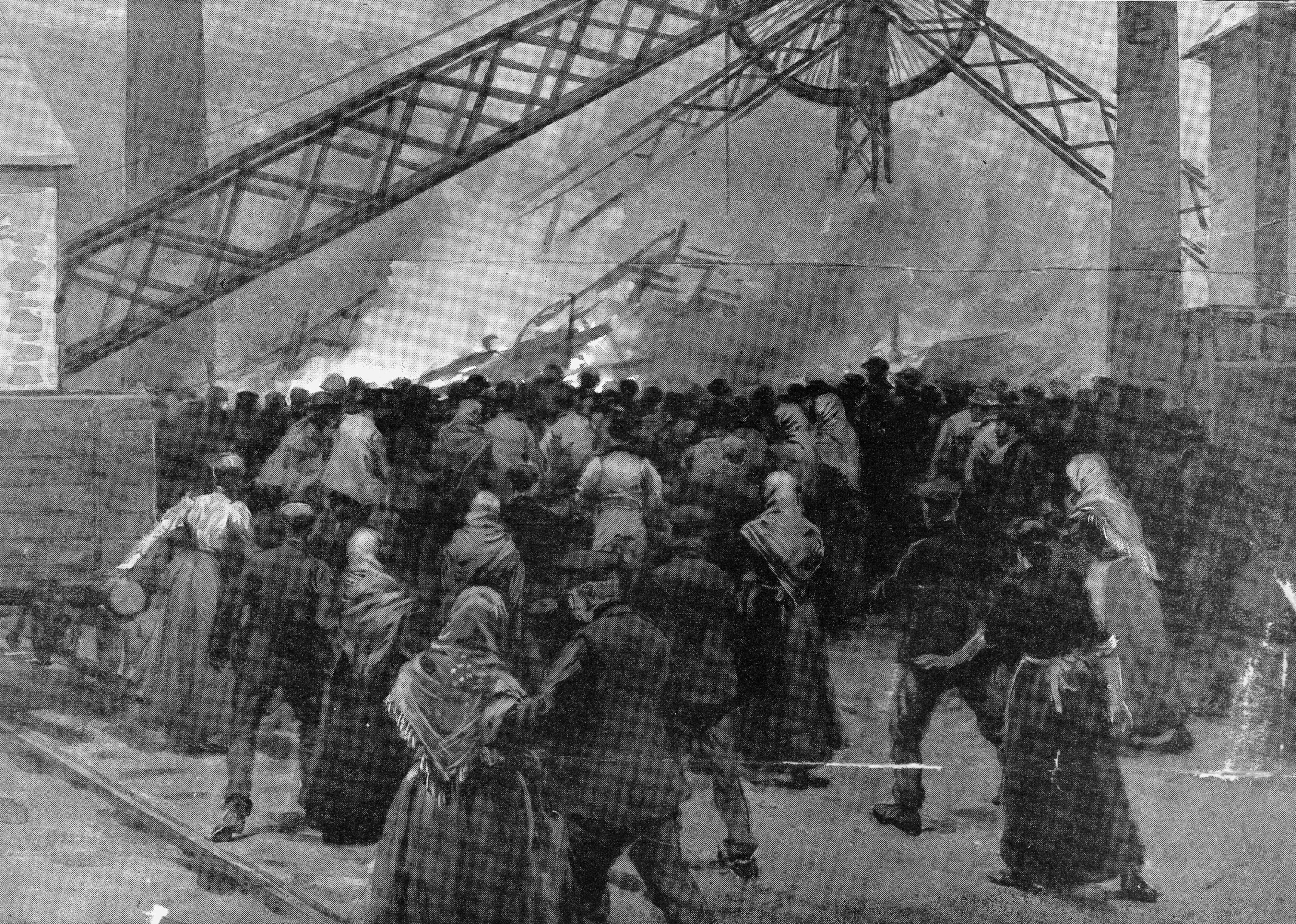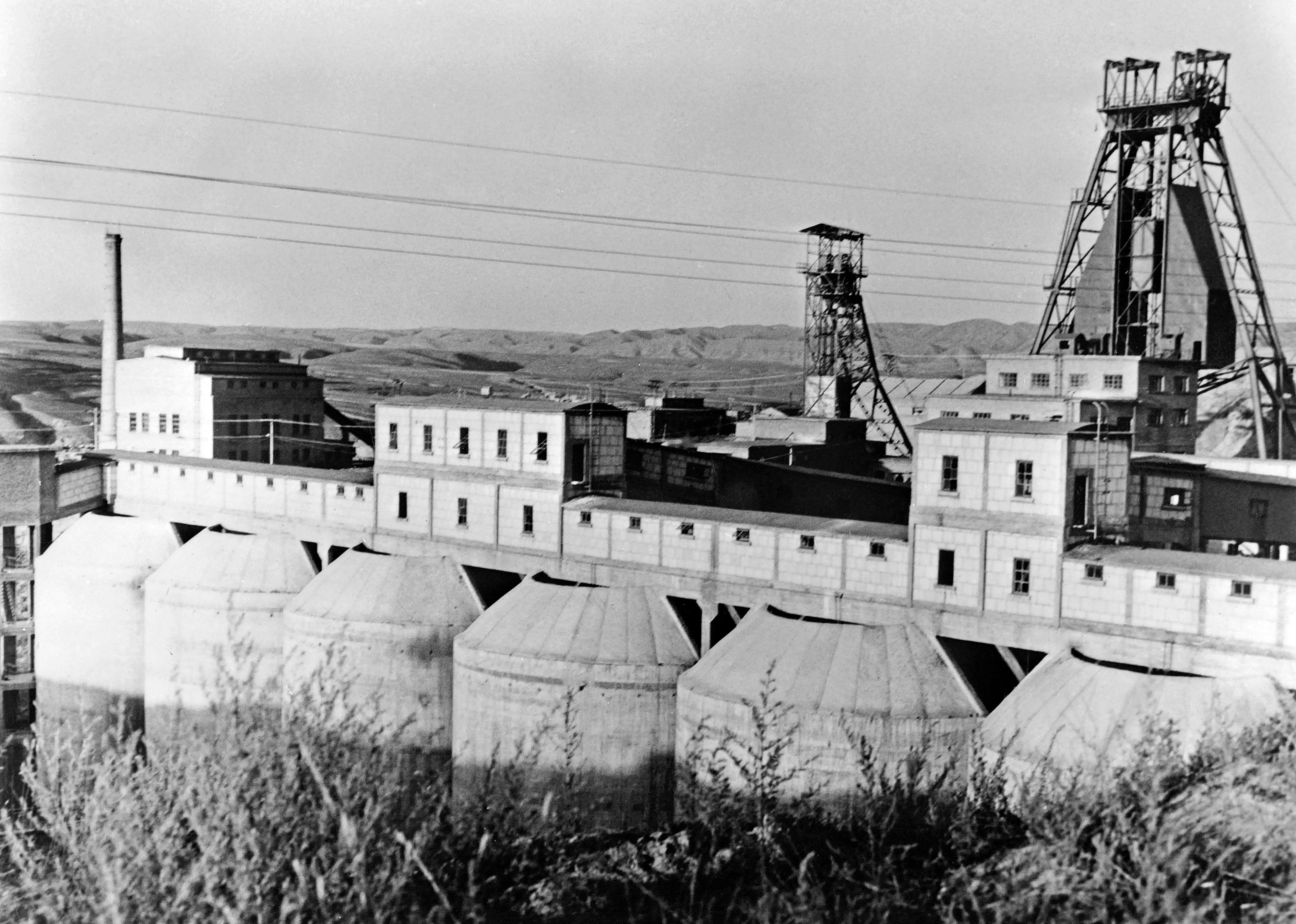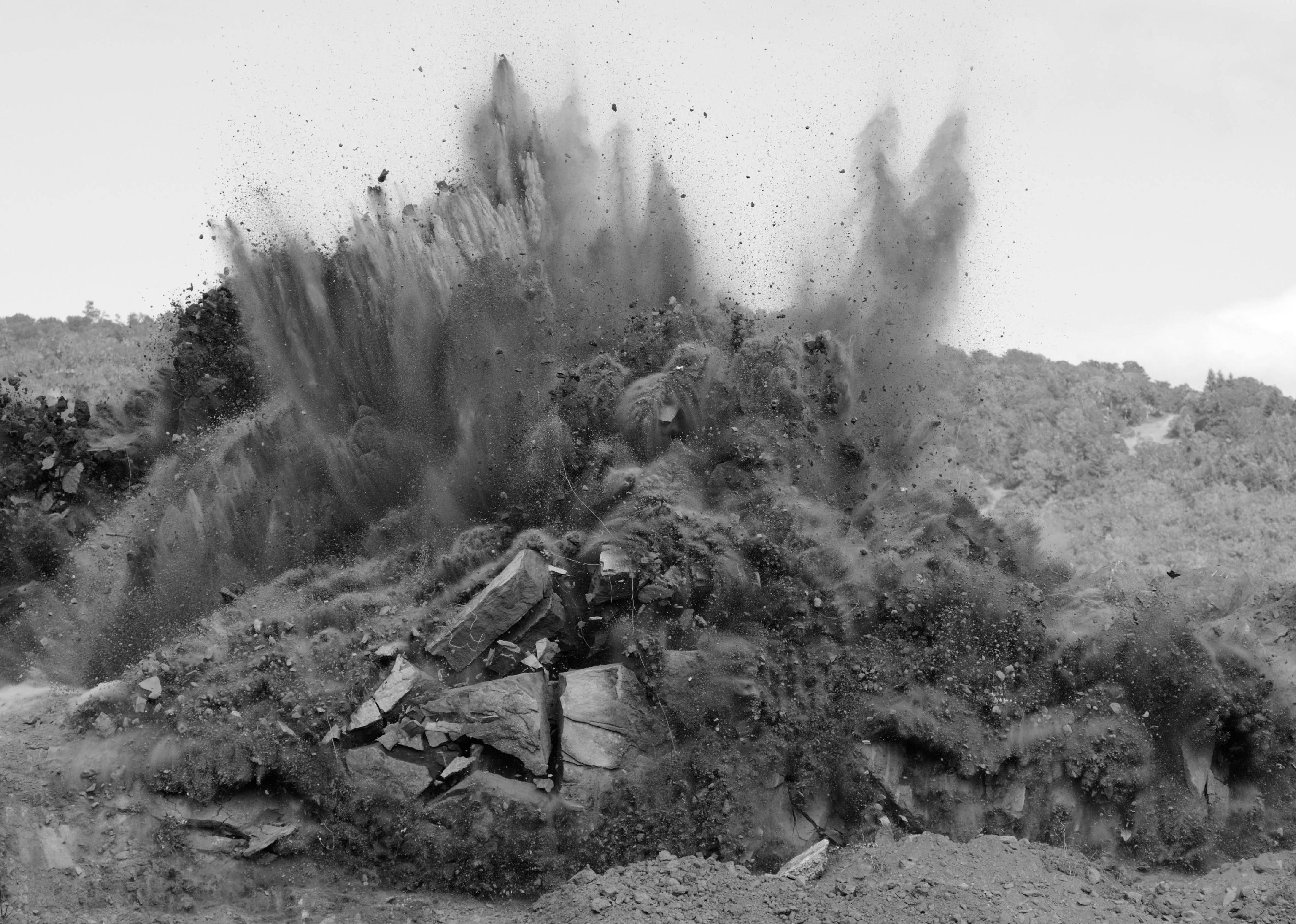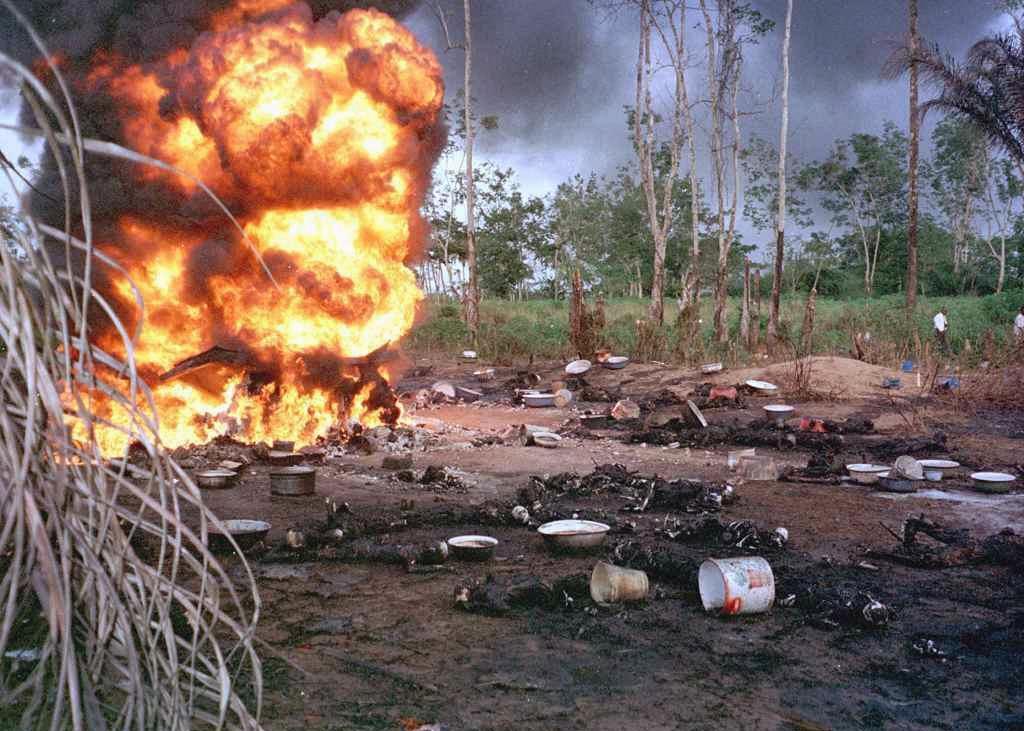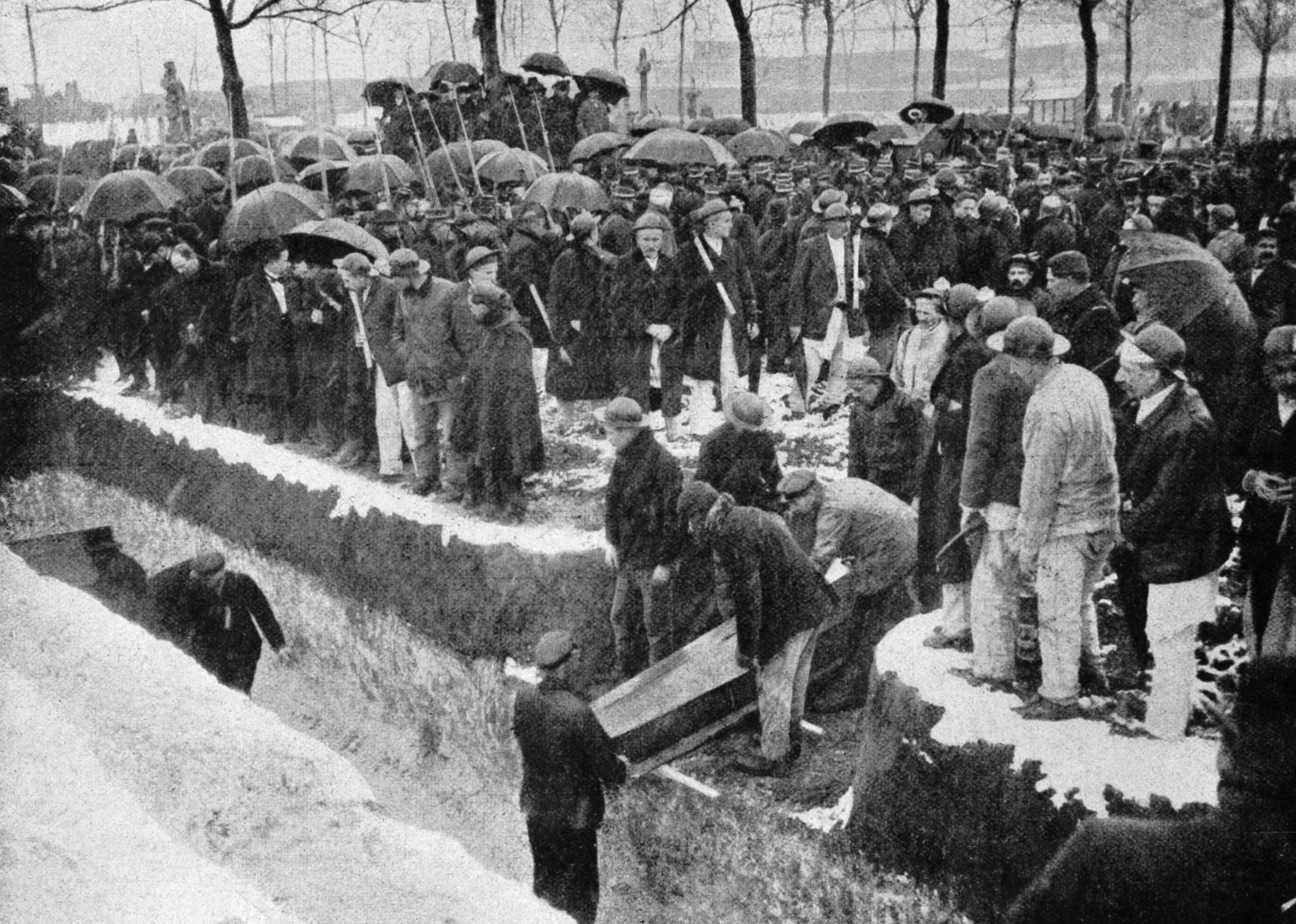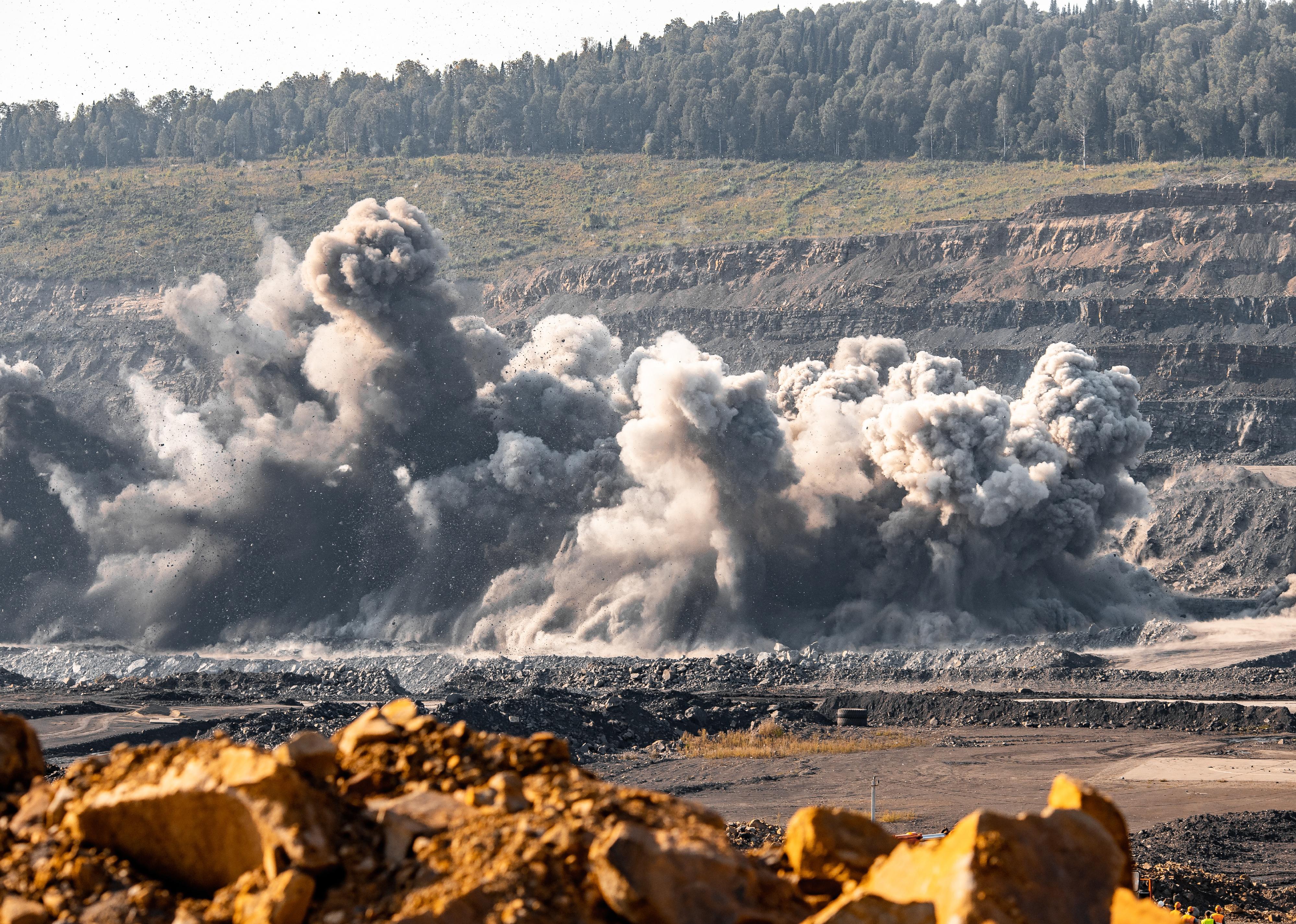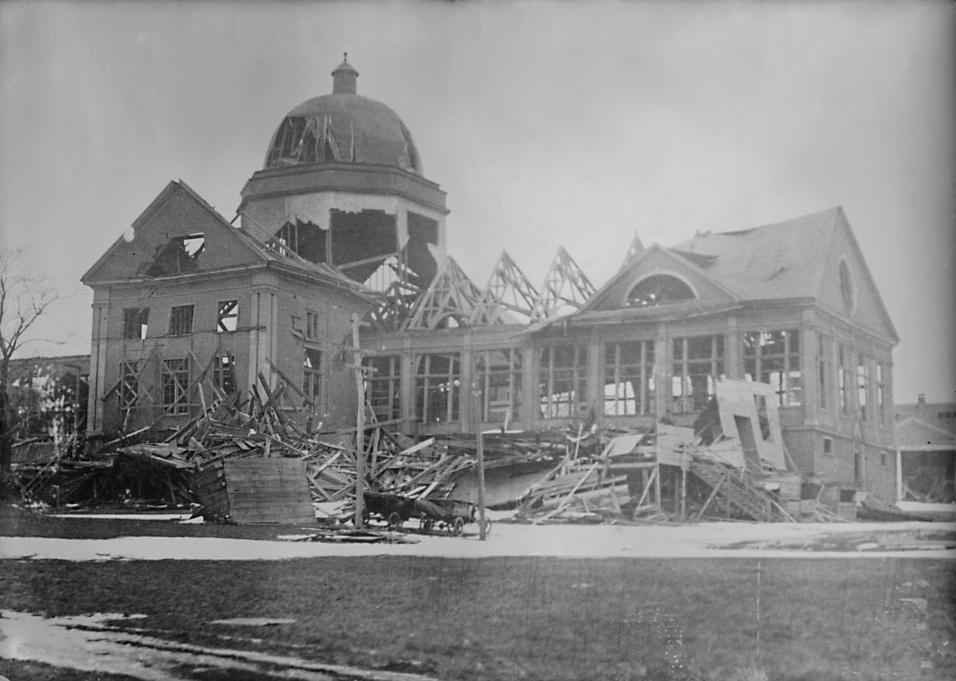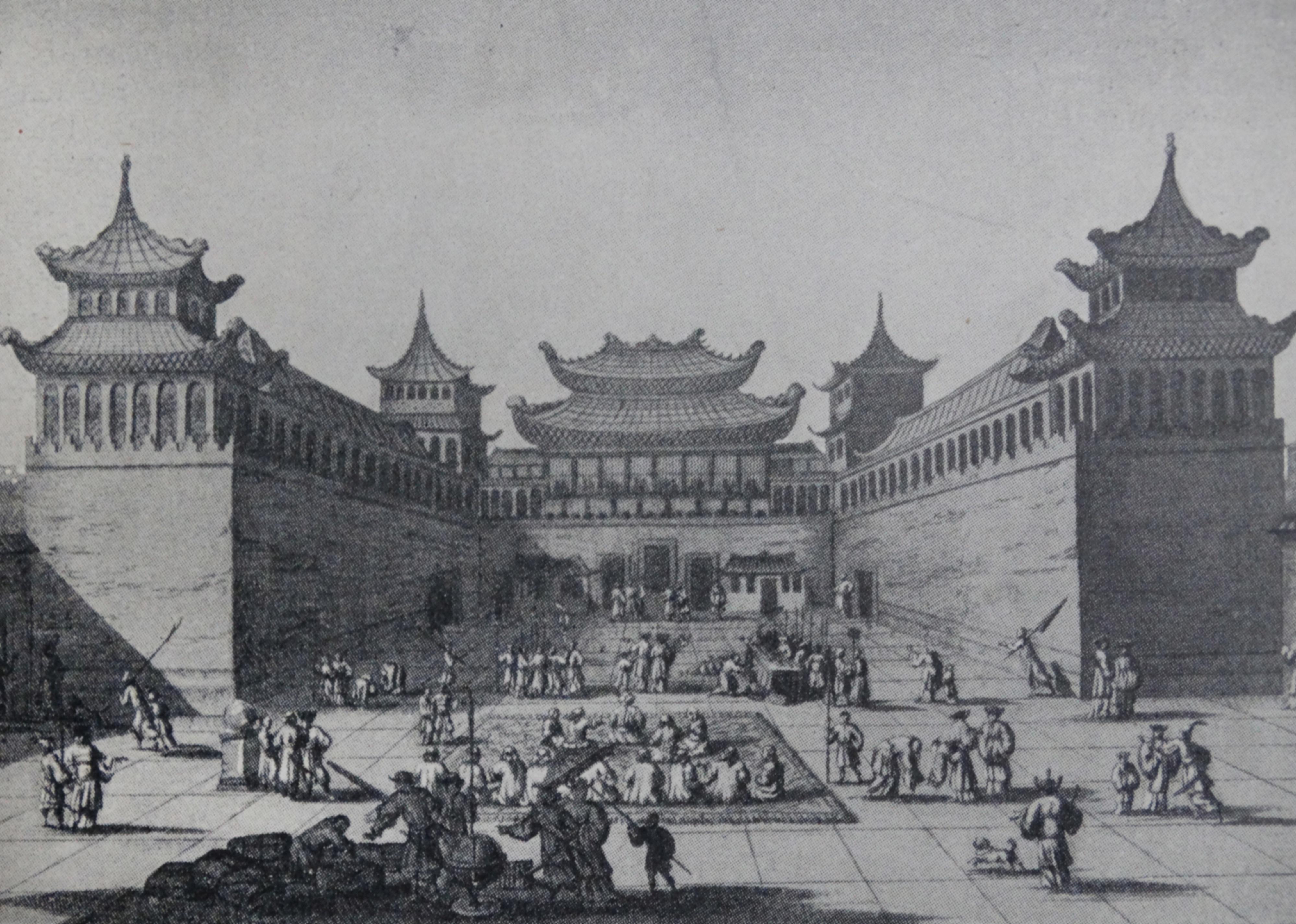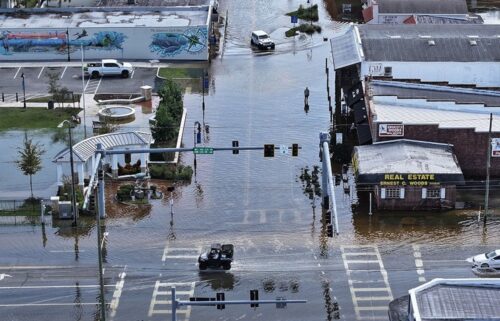The deadliest accidental explosions ever recorded
PIUS UTOMI EKPEI // Getty Images
The deadliest accidental explosions ever recorded
Bystanders watch fire fighters trying to put out a fire after the explosion of a pipeline.
Civilization needs an ever-increasing quantity of resources in order to sustain its activities, and its capacity to extract, refine, store, and put to use those resources has increased alongside it. Different nations, however, have industrialized at different times in history; whereas England did so in the late 18th and early 19th centuries, nations such as China did so much more recently, in the late 20th and early 21st centuries.
The early stages of industrialization are often pockmarked with learning curves that frequently result in varying degrees of social tumult, from labor struggles to political upheaval, as well as ecological devastation wrought by the advent of developing industry that produces climatologically harmful byproducts. Combined with the massive scale and equally massive uses of manpower enabled by technological and scientific advancements, the opportunity for accidents, negligence, and deadly disregard for the safety of marginalized groups have, on occasion, had literally explosive impact.
Stacker compiled information from historical archives, accident reports, and country records to find some of the most deadly nonnuclear accidental explosions recorded in history. Almost all are related in some way to industrial efforts, and a significant portion of them are due to the uniquely dangerous combination of factors that go into mining coal. Ties are broken by recency.
You may also like: Signature dishes from 50 countries around the world
![]()
Universal History Archive // Getty Images
#21. Nanaimo, British Columbia, Canada (1887)
Engraving of the coal mine at Nanaimo.
– Estimated death toll: 150
Still counted as the second deadliest industrial accident in Canada’s history, the explosion at Nanaimo’s Number One Mine, operated by the Victoria Coal Company, was set off by improperly laid explosives and burned for at least two weeks, which, coupled with blackdamp, made rescue efforts nearly impossible. Mine Number One was part of a larger network of mining shafts that extended underneath Nanaimo Harbour. According to reports at the time, “The fearful character of the explosion [could not] be exaggerated.” Of those who died in the accident, 53 were Chinese immigrant workers, whose names were unrecorded as the laws of the time did not require companies to officially report the deaths of Chinese workers.
PIUS UTOMI EKPEI // Getty Images
#20. Warri, Nigeria, West Africa (2000)
Scene of the aftermath of a pipeline explosion in Nigeria.
– Estimated death toll: 150
As with a number of the tragedies on this list, the explosion of a petroleum pipeline just outside of the Nigerian town of Warri, on July 16, 2000, occurred as a result of “bunkering” and “scooping,” the illegal scavenging of oil from the many oil pipelines that crisscross Nigeria.
Accounts and eyewitnesses reported fuel boats, used to transport the scavenged oil, going ablaze and “a slick of fire moving across the surface of the river from the ruptured pipe spread across the water.” These oil scavenging operations were often sophisticated, involving both premeditated manpower and the spontaneous involvement of nearby villagers. Owing to a fear of retribution, the total loss of life and the specific cause of such disasters often remains unknown.
PIUS UTOMI EKPEI // Getty Images
#19. Atlas Creek Island, Nigeria, West Africa (2006)
A stitched hole at an oil pipeline that exploded.
– Estimated death toll: 150
Occurring once again in the oil-rich Nigerian Delta, the explosion at Atlas Creek Island was initiated by bunkerers who had drilled a small hole in the pipeline, which was then later visited by large numbers of local villagers who scooped up the freely leaking oil.
Owing to a drastically unequal distribution of oil profits and 70% of its population living beneath the poverty line, during the 2000s Nigeria was plagued by unrest and devastation stemming from its oil industry. In the lead-up to Atlas Creek, militias had formed and sabotaged the country’s oil pipelines as a way to force action by politicians, as opposed to doing so for profit.
Sepia Times // Getty Images
#18. Leiden, Netherlands (1807)
View of the Rapenburg in Leiden after the gunpowder disaster of 1807.
– Estimated death toll: 154
During one of Napoleon’s many wars against various European powers, the canal city of Leiden, Netherlands, was a hub of gunpowder production for the French empire. After picking up a cargo load of more than 40,000 pounds of black powder, the ship Delfs Welvaaren, carrying black powder for the Dutch Army during the War of the Fourth Coalition, moored in a canal in the city center. This is where it exploded either as a result of the crew cooking a meal or attempting to steal some of the gunpowder.
The blast, equivalent to just under 20,000 pounds of TNT, leveled much of the neighborhood—destroying some 200 houses, and injuring more than 2,000 people.
PA Images // Getty Images
#17. Aberdeen, Scotland, United Kingdom (1988)
Smoke plumes from the Piper Alpha oil production platform.
– Estimated death toll: 167
The worst oil rig disaster recorded in terms of loss of life, the Piper Alpha explosion burned for nearly three weeks and required the expertise of Red Adair, a specialist in taming wild wells, to get under control. Arising from a series of safety failures, the acute cause of the accident was linked to a failure to communicate the unsafe state of a critical pipe between shift changes.
Located about 120 miles northeast of the Scottish city of Aberdeen, the Piper Alpha rig collapsed into the sea after only two hours, and during the time it burned so hot that rescue helicopters were forced to maintain a distance of at least 1 mile.
Utah news service // Wikimedia Commons
#16. Scofield, Utah, United States (1900)
The coffins of the Winter Quarters workers waiting for the train to the cemetery.
– Estimated death toll: 200
A now deserted town populated by only 23 people, Scofield used to be a busy mining town run by the Pleasant Valley Coal Company. On May 1, 1900, the Number 4 mine exploded, coal dust throughout the mine having been ignited by a keg of black powder that had been set off somehow. The noxious fumes, called blackdamp or afterdamp, suffocated those who hadn’t been killed by the blast or falling rubble.
Mere days later, Pleasant Valley signaled its intent to reopen the mine, receiving a flood of applicants seeking the high pay the company was able to offer. The company gave the bereft families $500, approximately $17,000 in 2023, and the disaster sparked a series of labor protests to increase coal miner protections.
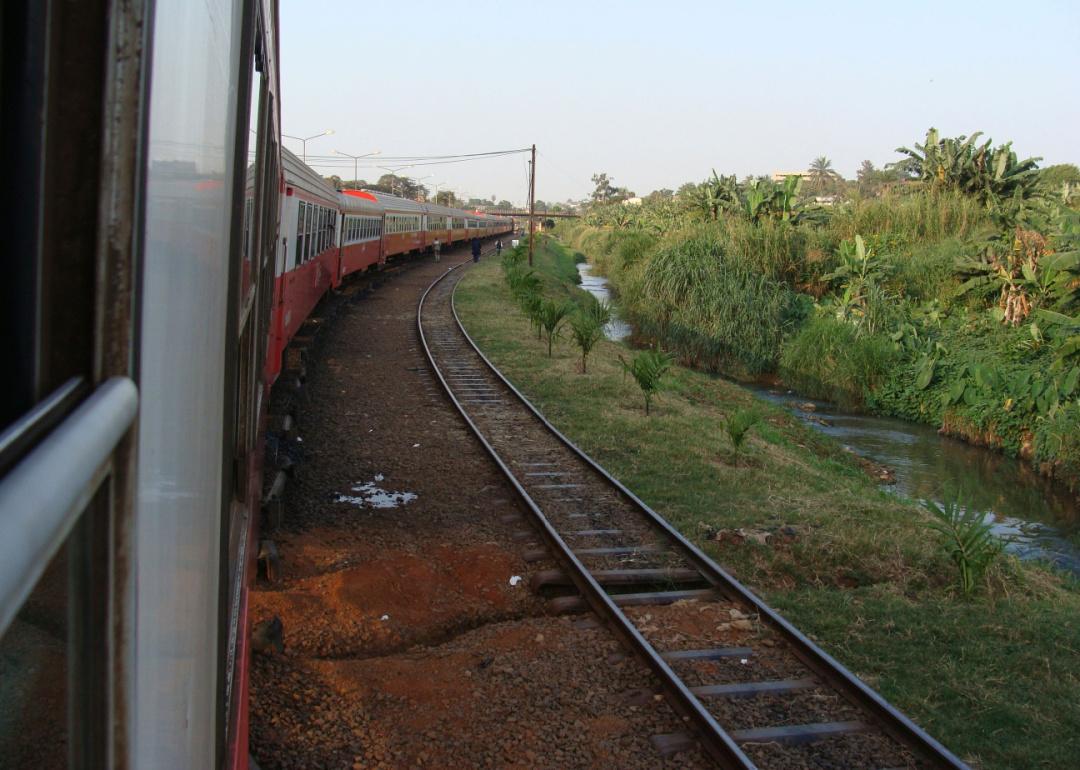
Scarabea // Shutterstock
#15. Yaoundé, Cameroon (1998)
The Cameroon National Railway traveling from Yaounde to Ngaoundere.
– Estimated death toll: 200
After derailing and colliding with an oncoming train, an oil tanker spilled out near a crowded oil depot in a Yaoundé’s Nsam neighborhood, located on the city’s outskirts. Most of the estimated number of deaths occurred as bystanders, many of them cab drivers, rushed over to scoop oil from the spill, igniting a blaze through either a carelessly dropped cigarette, or some other means.
The compensation fund that was set up by the Cameroonian government was later found by the National Anti-Corruption Commission to have been heavily embezzled to the tune of billions in central African francs.
STR // Getty Images
#14. Fuxin, China (2005)
A team of miners prepare to enter into the Sujiawan colliery in Fuxin city.
– Estimated death toll: 214
One of China’s deadliest industrial accidents in recent history, the Sunjiawan coal mine explosion was initiated by a small 2.7 magnitude earthquake that released methane into the already gas-filled mine and ignited by rock movement. The ensuing explosion registered as a 0.6 seismic event and left only 29 survivors.
In the early 2000s, as China pursued rapid industrialization, it accounted for 35% of the world’s coal production and 80% of the world’s coal-related deaths—in 2004 alone more than 5,000 miners died in colliery accidents.
Leonid Ikan // Shutterstock
#13. Accra, Ghana, West Africa (2015)
Fire flame against the sky.
– Estimated death toll: 256
When this disaster struck, residents and commuters in Ghana’s capital had been seeking shelter at a local gas station from flooding caused by days of torrential downpours. This same flooding then caused underground containers of diesel and petrol to leak, and with an unknown spark provided by any of the nearby flooded businesses or houses, the area was engulfed in flame.
Rescue efforts were hindered by impassable roadways, and Ghana’s President John Mahama attributed elements of the tragedy to ground saturation and indiscriminate building on a major waterway.
Historical // Getty Images
#12. Mobile, Alabama, United States (1865)
A single post remains erect amid the rubble of a Mobile warehouse.
– Estimated death toll: 300
After the end of the Civil War, Mobile, Alabama, had become a hub for Union administration in the region, including the collection of munitions and cotton from captured Confederates. A warehouse located in the center of the city had been serving as one of the main stockpiles for those resources, and though the precise inciting details were never discovered, the ensuing explosion likely resulted from careless soldiers improperly handling explosive material.
The blast resulted in the destruction of an entire eight-block segment of the city, with injuries related to the event reaching the thousands and the property damage devastating a city already burdened by the struggles of a recent war.
Chris Hondros // Getty Images
#11. Warri, Nigeria, West Africa (2000)
An oil pipeline runs through a Nigerian forest.
– Estimated death toll: 300
Occurring on July 10, 2000, only six years before #19 on this list, this disaster also arose as a result of bunkering and scooping. The blast and its resulting fires destroyed land and buildings up to a mile away, and burned for at least two days; with all but 20 of the confirmed deaths occurring on the day of the accident, the impact on the local community was both emotionally and economically devastating.
At the time, Nigeria was the world’s sixth-largest oil exporter. Unfortunately, little of that wealth reached its population; with access to traditional livelihoods such as farming and fishing unavailable due to the ecological devastation of the oil industry, many rural Nigerians were, and still are, forced by extreme poverty to engage in the highly dangerous practice of scooping in order to survive.
PIUS UTOMI EKPEI // Getty Images
#10. Abule Egba, Nigeria, West Africa (2006)
A firefighter tries to put off the fire at the scene of a pipeline explosion at Abule Egba.
– Estimated death toll: 300
For more than three hours before the deadly explosion at Abule Egba, Nigeria, people had been arriving in cars and motorcycles to gather around a pipeline punctured by bunkerers and scoop oil. When an unknown spark set off the blaze, all nearby died in the inferno, and over 300 more sustained burns of varying degrees of severity.
Owing to a fuel shortage at the time, a single 20-liter canister of the scooped oil would sell for an amount worth nearly two weeks of wages. The shortage, coupled with high unemployment, left many with few options other than to risk what ended up as one of Nigeria’s most deadly industrial accidents.
Unidentified engraver // Wikimedia Commons
#9. Stairfoot, England, United Kingdom (1866)
Illustration of the Second Explosion at the Oaks Colliery.
– Estimated death toll: 361
As with many colliery disasters, England’s deadliest mining incident was caused by firedamp, the mixture of methane gas with the dust-laden air of a coal mine. After an initial blast that killed all but six workers, a secondary blast caused by further gas accumulation claimed the lives of 27 locals attempting a rescue.
The explosions were heard for miles around, and in addition to coloring the sky a dark gray, also produced black snow, a deadly pollutant that can lead to serious health complications. While the official death toll remains 361, volunteer researchers have recently uncovered evidence that points to an actual toll of 383 lost.
Hulton Archive // Getty Images
#8. Senghenydd, Wales, United Kingdom (1913)
People rush toward the Universal Colliery in Senghenydd.
– Estimated death toll: 439
The disaster at Senghenydd, Wales, arose, as colliery disasters often do, from improper ventilation and safety infractions, leaving an estimated 1,000 people bereaved and more than 200 women widowed, for which the owners of Universal Colliery offered only one shilling per death in compensation.
The U.K. mines that were built before the Coal Mines Act of 1911 were not required to comply with what became more stringent, and far safer, regulations. Universal Colliery had weathered a similarly deadly incident at the same site in 1901, which killed 81 miners. Of the 1,000 miners working the day of the incident in Senghenydd, many would have been children, as the age of employment was 14 at the time.
XINHUA // Getty Images
#7. Datong, China (1960)
View from the coal mine in Yungang.
– Estimated death toll: 684
Suppressed by the People’s Republic of China until 1992, the explosion at Laobaidong Colliery is the country’s second deadliest mining accident. Details have remained hard to come by, but the cause is reported to have been a buildup of methane resulting in a fatal cocktail of fire, noxious fumes, and tunnel collapses.
You may also like: When women got the right to vote in 50 countries
TFoxFoto // Shutterstock
#6. Hōjō, Fukuoka, Kyushu, Japan (1914)
Explosion of rocks.
– Estimated death toll: 687
Most of the deaths that occurred at the Hōjō Colliery, Japan’s deadliest mining accident, were a result of asphyxiation. The initial explosion was instigated by the flame of a faulty safety lamp, the debris from which then blocked the airways of the mine’s ventilation system.
The Hōjō mining disaster is unique among similar disasters, as an estimated 20% of the accident’s deaths were women, it being traditional at the time for Japanese women to work in the mining industry.
PETER CUNLIFFE-JONES // Getty Images
#5. Jesse, Nigeria, West Africa (1998)
Fire burning at the centre of the Nigerian oil pipeline disaster.
– Estimated death toll: 1,098
The deadliest oil pipeline explosion in history arose after a pipe running through the town of Jesse, Nigeria, caught fire, erupted into a fireball, and spread throughout the region and into nearby villages and croplands. Most who died were met by the flame as they went about their daily lives, with only a small portion seeming to have been engaging in scooping.
The blaze took five days to extinguish, requiring the assistance of American firefighters. Its cause remains unverified, with the government claiming that scooping and bunkering led to the disaster, while others cite pipeline maintenance neglect.
ullstein bild // Getty Images
#4. Courrières, France (1906)
Mining accident in the mine of Courrières, 1906.
– Estimated death toll: 1,099
Europe’s deadliest industrial accident, the Courrières mine disaster was caused by the buildup of methane and coal dust that exploded in violent rushes of flame and deadly fumes. Open fire in the mines, which had been detected days before the event, was unsuccessfully mitigated, with operations resuming regardless of the danger.
Remarkably, 13 miners survived more than 20 days in the collapsed mines by eating rotting horsemeat, scavenged provisions, and drinking still water and urine before they were able to self-rescue, emerging in remarkably good health. The Courrières disaster was a major instigating event in France’s labor organizing efforts in the early 20th century, and the disaster itself sparked multiple, violent protests attended by more than 10,000 people.
Parilov // Shutterstock
#3. Benxihu Colliery, China (1942)
Explosion on open pit coal mine.
– Estimated death toll: 1,549
Initially established as a joint mining effort by Japan and China, during the Sino-Japanese War of 1937-1945, the Benxihu Colliery was taken over by Japanese forces that referred to the colliery as Honkeiko, where Chinese laborers were then forced under brutal conditions to mine the region’s coal. As has often been the case, the specifics have eluded history, but some combination of methane, coal dust, and a precipitating spark caused an escalating explosion that burst from the entrance of the mine.
In the aftermath of the explosion, the Japanese overseers prevented relatives from attempting to rescue family members trapped in the blast, erected an electric fence around the area, and prematurely sealed the mine, leading to potentially hundreds of unnecessary deaths.
Unknown // Wikimedia Commons
#2. Halifax Harbour, Halifax, Nova Scotia (1917)
Building destroyed by the Halifax Explosion.
– Estimated death toll: 1,963
Known as the Great Halifax Explosion, this event took place in the morning hours of Dec. 6, 1917, when the Norwegian steamship Imo, on a course out of the fog-banked Halifax Harbour, collided with the Mont Blanc, a French steamer making its way into the mouth of the harbor and laden with munitions—nearly 3,000 metric tons of explosives including guncotton, benzol, TNT, and picric acid.
When fractured drums of benzol caught fire, the Mont Blanc exploded, creating a 60-foot tsunami that blanketed three square blocks of the city of Halifax. Nearly 2,000 buildings were destroyed, laying to waste Halifax’s Richmond neighborhood and much of the city of Dartmouth, across the harbor.
Universal History Archive // Getty Images
#1. Beijing, Ming Dynasty (1626)
Dutch East India Company envoys received at the imperial palace in Beijing, 1600s.
– Estimated death toll: 20,000
The deadliest accident to occur in recorded history, the Wanggongchang Explosion leveled nearly a square mile in a busy city center, leaving behind nothing but a crater and ash. A sophisticated producer of gunpowder at the time, the Ming Dynasty stored much of its materials and munitions in a warehouse in the city.
The cause of the explosion was explained as a “heavenly event” by investigating officials of the time—partially owing to the impossibility of investigation. Written accounts speak of a mushroom cloud, not unlike a nuclear detonation, and the explosion was heard up to 10 miles away from the city.
You may also like: 50 fascinating cultural UNESCO World Heritage Sites around the world
